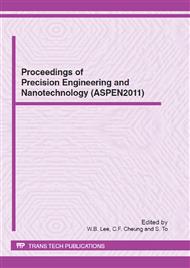p.287
p.293
p.299
p.305
p.311
p.317
p.321
p.326
p.332
Study on Effect of Ultrasonic Vibration in Machining of Alumina Ceramic
Abstract:
Ultrasonic machining can be applied for the machining of difficult-to-cut materials using ultrasonical oscillation in an axial direction on top of tool rotation, which can cause reduction of cutting temperature and tool wear. In this study, the experiments were performed on a DMG ULTRASONIC 20 linear machine tool using diamond tools in both conventional and ultrasonic vibration assisted machining. The machining performance was evaluated and compared for both cases in terms of cutting forces, machined surface roughness and tool wear. And the combination technique of 3D surface topography measurement and image processing was applied for the tool wear progress. Overall, the experimental results showed that ultrasonic machining had less tool wear and lower cutting forces at low cutting speed compared to conventional machining. Also surface roughness was slightly lower in ultrasonic machining than that without ultrasonic vibration.
Info:
Periodical:
Pages:
311-316
Citation:
Online since:
June 2012
Keywords:
Price:
Сopyright:
© 2012 Trans Tech Publications Ltd. All Rights Reserved
Share:
Citation:


